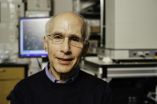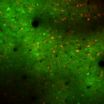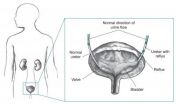(Press-News.org) Cambridge, MA, May 4 - Harvard Stem Cell Institute (HSCI) researchers have shown that a protein they previously demonstrated can make the failing hearts in aging mice appear more like those of young health mice, similarly improves brain and skeletal muscle function in aging mice.
In two separate papers given early online release today by the journal Science – which is publishing the papers this coming Friday, Professors Amy Wagers and Lee Rubin, of Harvard's Department of Stem Cell and Regenerative Biology (HSCRB), report that injections of a protein known as GDF11, which is found in humans as well as mice, improved the exercise capability of mice equivalent in age to that of about a 70-year-old human, and also improved the function of the olfactory region of the brains of the older mice – they could detect smell as younger mice do.
Rubin and Wagers each said that, baring unexpected developments, they expect to have GDF11 in initial human clinical trials within three to five years.
Postdoctoral fellow Lida Katsimpardi is the lead author on the Rubin group's paper, and postdocs Manisha Sinha and Young Jang are the lead authors on the paper from the Wagers group.
Both studies examined the effect of GDF11 in two ways. First, by using what is called a parabiotic system, in which two mice are surgically joined and the blood of the younger mouse circulates through the older mouse. And second, by injecting the older mice with GDF11, which in an earlier study by Wagers and Richard Lee, of Brigham and Women's Hospital who is also an author on the two papers released today, was shown to be sufficient to reverse characteristics of aging in the heart.
Doug Melton, co-chair of HSCRB and co-director of HSCI, reacted to the two papers by saying that he couldn't "recall a more exciting finding to come from stem cell science and clever experiments. This should give us all hope for a healthier future. We all wonder why we were stronger and mentally more agile when young, and these two unusually exciting papers actually point to a possible answer: the higher levels of the protein GDF11 we have when young. There seems to be little question that, at least in animals, GDF11 has an amazing capacity to restore aging muscle and brain function," he said.
Melton, Harvard's Xander University Professor continued, saying that the ongoing collaboration between Wagers, a stem cell biologist whose focus has been on muscle, Rubin, whose focus is on neurodegenerative diseases and using patient generated stem cells as targets for drug discover, and Lee, a practicing cardiologist and researcher, "is a perfect example of the power of the Harvard Stem Cell Institute as an engine of truly collaborative efforts and discovery, bringing together people with big, unique ideas and expertise in different biological areas."
As Melton noted, GDF11 is naturally found in much higher concentration in young mice than in older mice, and raising its levels in the older mice has improved the function of every organ system thus far studied.
Wagers first began using the parabiotic system in mice 14 years ago as a post doctoral fellow at Stanford University, when she and colleagues Thomas Rando, of Stanford, Irina Conboy, of UC Berkley, and Irving Weissman, of Stanford, observed that the blood of young mice circulating in old mice seemed to have some rejuvenating effects on muscle repair after injury.
Last year she and Richard Lee published a paper in which they reported that when exposed to the blood of young mice, the enlarged, weakened hearts of older mice returned to a more youthful size, and their function improved. And then working with a Colorado firm, the pair reported that GDF11 was the factor in the blood apparently responsible for the rejuvenating effect. That finding has raised hopes that GDF11 may prove, in some form, to be a possible treatment for diastolic heart failure, a fatal condition in the elderly that now is irreversible, and fatal.
"From the previous work it could have seemed that GD11 was heart specific," said Wagers, "but this shows that it is active in multiple organs and cell types… Prior studies of skeletal muscle and the parabiotic effect really focused on regenerative biology. Muscle was damaged and assayed on how well it could recover," Wagers explained.
She continued: "The additional piece is that while prior studies of young blood factors have shown that we achieve restoration of muscle stem cell function and they repair the muscle better, in this study, we also saw repair of DNA damage associated with aging, and we got it in association with recovery of function, and we saw improvements in unmanipulated muscle. Based on other studies, we think that the accumulation DNA damage in muscle stem cells might be reflect an inability of the cells to properly differentiate to make mature muscle cells, which is needed for adequate muscle repair.
Wagers noted that there is still a great deal to be learned about the mechanics of aging in muscle, and its repair. "I don't think we fully understand how this happening or why. We might say that the damage is modification to the genetic material; the genome does have breaks in it. But whether it's damaging, or a necessary part of repair, we don't know yet."
Rubin, whose primary research focus is on developing treatment for neurodegenerative diseases, particularly in children, said that that when his group began its GDF11 experiments, "we knew that in the old mouse things were bad in the brain, there is a reduced amount of neurogenesis (the development of neurons), and it's well known that cognition goes down. It wasn't obvious to me that those things that can be repaired in peripheral tissue could be fixed in the brain."
Rubin said that post doctoral fellow Lida Katsimpardi, the lead author on his group's paper, was taught the parabiotic experimental technique by Wagers, but conducted the Rubin group's experiments independently of the Wagers group, and "she saw an increase in neural stem cells, and saw increased development of blood vessels in the brain." Rubin said that 3D reconstruction of the brain, and magnetic resonance imaging (MRI) of the mouse brain showed "more new blood vessels and more blood flow," both of which are normally associated with younger, healthier brain tissue."
Younger mice, Rubin said, "have a keen sense of olfactory discrimination," they can sense fine differences in odor. "When we tested the young mice, they avoided the smell of mint; the old mice didn't. But the old mice exposed to the blood of the young mice, and those treated with GDF11 did.
"We think an effect of GDF 11 is the improved vascularity and blood flow, associated with increased neurogenesis," Rubin said. "This should have other more widespread effect on other areas of the brain. We do think that, at least in principal, there will be a way to reverse some of the decline of aging with a single protein. It could be that a molecule like GDF 11, or GDF 11 itself, could" reverse the damage of aging.
"It isn't out of question that GDF11," or a drug developed from it, "might be worthwhile in Alzheimer's Disease," Rubin said. "You might be able to separate out the issues of treating the plaque and tangles associated with the disease, and the decline in cognition, and perhaps improve cognition."
Wagers said that the two research groups are in discussions with a venture capital group to obtain funding to "be able to do the additional pre-clinical work" necessary before moving GDF 11 into human trials.
"I would wager that the results of this work, together with the other work, will translate into a clinical trial and a treatment," said the stem cell biologist. "but of course that's just a wager."
"We think an effect of GDF 11 is the improved vascularity and blood flow, which is associated with increased neurogenesis," Rubin said. "However, the increased blood flow should have more widespread effects on brain function. We do think that, at least in principle, there will be a way to reverse some of the cognitive decline that takes place during aging, perhaps even with a single protein. It could be that a molecule like GDF 11, or GDF 11 itself, could" reverse the damage of aging.
"It isn't out of question that GDF11," or a drug developed from it, "might be capable of slowing some of the cognitive defects associated with Alzheimer's Disease, a disorder whose main risk factor is aging itself," Rubin said. It is even possible that this could occur without directly changing the "plaque and tangle burden" that are the pathological hallmarks of Alzheimer's. Thus, a future treatment for this disease might be a combination of a therapeutic that reduces plaques and tangles, such as an antibody directed against the β-amyloid peptide, with a potential cognition enhancer like GDF-11.
Wagers said that the two research groups are in discussions with a venture capital group to obtain funding to "be able to do the additional preclinical work" necessary before moving GDF 11 into human trials.
"I would wager that the results of this work, together with the other work, will translate into a clinical trial and a treatment," said the stem cell biologist. "but of course that's just a wager."
INFORMATION: END
Functioning of aged brains and muscles in mice made younger
More progress with GDF 11, anti-aging protein
2014-05-04
ELSE PRESS RELEASES FROM THIS DATE:
New study sheds light on global warming trends
2014-05-04
TALLAHASSEE, Fla. — New research by a team of Florida State University scientists shows the first detailed look at global land surface warming trends over the last 100 years, illustrating precisely when and where different areas of the world started to warm up or cool down.
The research indicates that the world is indeed getting warmer, but historical records show that it hasn't happened everywhere at the same rate.
And that new information even took scientists by surprise.
"Global warming was not as understood as we thought," said Zhaohua Wu, an assistant professor ...
Motor cortex shown to play active role in learning movement patterns
2014-05-04
Skilled motor movements of the sort tennis players employ while serving a tennis ball or pianists use in playing a concerto, require precise interactions between the motor cortex and the rest of the brain. Neuroscientists had long assumed that the motor cortex functioned something like a piano keyboard.
"Every time you wanted to hear a specific note, there was a specific key to press," says Andrew Peters, a neurobiologist at UC San Diego's Center for Neural Circuits and Behavior. "In other words, every specific movement of a muscle required the activation of specific ...
Taking the lead out of a promising solar cell
2014-05-04
Northwestern University researchers are the first to develop a new solar cell with good efficiency that uses tin instead of lead perovskite as the harvester of light. The low-cost, environmentally friendly solar cell can be made easily using "bench" chemistry -- no fancy equipment or hazardous materials.
"This is a breakthrough in taking the lead out of a very promising type of solar cell, called a perovskite," said Mercouri G. Kanatzidis, an inorganic chemist with expertise in dealing with tin. "Tin is a very viable material, and we have shown the material does work ...
Study points to potential revision of treatment guidelines for bleeding ulcers
2014-05-04
Chicago, IL (May 4, 2014) — The current standard of care for managing patients who receive endoscopic treatment for bleeding ulcers should be replaced by an equally safe and less costly alternative that is more comfortable for patients, according to new research presented today at Digestive Disease Week® (DDW). Researchers at the Yale University School of Medicine compared the current recommended care plan — delivering an initial dose of proton pump inhibitor (PPI) followed by continuous PPI infusion — to a regimen using only intermittent PPI therapy, which was found to ...
Weight-loss surgery can reduce liver damage
2014-05-04
Chicago, IL (May 4, 2014) — Bariatric surgery, which is best known for its ability to help patients lose substantial weight, can also result in significant improvement in nonalcoholic fatty liver disease (NAFLD), according to new research presented today at Digestive Disease Week® (DDW). Researchers at the University of South Florida-Tampa found that bariatric surgery resolved liver inflammation and reversed early-stage liver fibrosis, the thickening and scarring of liver tissue, by reducing fat deposits in the liver.
"About 30 percent of the U.S. population suffers ...
Setting the agenda for firearm injury research
2014-05-04
VANCOUVER, BRITISH COLUMBIA – Pediatric leaders and researchers will tackle the complex subject of gun violence and critical gaps in research during a symposium on Saturday, May 4, at the Pediatric Academic Societies (PAS) annual meeting in Vancouver, British Columbia.
The symposium, "Firearm Injury Prevention in Children: Setting the Research Agenda" will focus attention among child health researchers about the public health and social consequences of firearm injury in children, and to identify gaps in knowledge to inform a research agenda -- and ultimately prevention ...
Prophylactic antibiotics prevent UTI recurrences in children with vesicoureteral reflux
2014-05-04
VANCOUVER, BRITISH COLUMBIA – Children diagnosed with vesicoureteral reflux (VUR) following a urinary tract infection (UTI) are at risk for kidney scarring with subsequent UTIs. New research shows that children receiving antimicrobials over a two-year period to prevent infections (antimicrobial prophylaxis) had a substantially reduced risk of UTI recurrences compared with children receiving a placebo.
The study will be presented Sunday, May 4, at the Pediatric Academic Societies (PAS) annual meeting in Vancouver, British Columbia, Canada. The study also is published ...
Motivational interviewing can positively impact childhood obesity
2014-05-04
VANCOUVER, BRITISH COLUMBIA – Pediatricians and dietitians who used motivational interviewing techniques to counsel families about their young child's weight were successful in reducing children's body mass index (BMI) percentile 3.1 more points than comparison children over a 2-year period, according to a study to be presented Sunday, May 4, at the Pediatric Academic Societies (PAS) annual meeting in Vancouver, British Columbia.
Motivational interviewing is a patient-centered communication style that uses techniques such as reflective listening and shared decision-making ...
Scores of bullying victims bringing weapons to school
2014-05-04
VANCOUVER, BRITISH COLUMBIA – An estimated 200,000 high school students who are bullied bring weapons to school, according to research to be presented Sunday, May 4, at the Pediatric Academic Societies (PAS) annual meeting in Vancouver, British Columbia, Canada.
Researchers also found that youths who have been victimized in multiple ways are up to 31 times more likely to carry a weapon to school than those who have not been bullied.
"Victims of bullying who have been threatened, engaged in a fight, injured, or had property stolen or damaged are much more likely to ...
Drug pair cuts children's urinary infections up to 80 percent
2014-05-04
Long-term use of a drug combination reduces the risk of recurrent urinary tract infection by up to 80 percent in children with the urinary condition vesicoureteral reflux compared to placebo, according to research funded by the National Institutes of Health. Results were published online May 4 in the New England Journal of Medicine to coincide with presentation at the Pediatric Academic Societies Annual Meeting in Vancouver, British Columbia.
In vesicoureteral reflux (VUR), developmental abnormalities in one or both ureters -- tubes connecting the kidneys with the bladder ...
LAST 30 PRESS RELEASES:
Study showcases resilience and rapid growth of “living rocks”
Naval Research Lab diver earns Office of Naval Research 2025 Sailor of the Year
New Mayo-led study establishes practical definition for rapidly progressive dementia
Fossil fuel industry’s “climate false solutions” reinforce its power and aggravate environmental injustice
Researchers reveal bias in a widely used measure of algorithm performance
Alcohol causes cancer. A study from IOCB Prague confirms damage to DNA and shows how cells defend against it
Hidden viruses in wastewater treatment may shape public health risks, study finds
Unlock the power of nature: how biomass can transform climate mitigation
Biochar reshapes hidden soil microbes that capture carbon dioxide in farmland
Reducing saturated fat intake shows mortality benefit, but only in high-risk individuals
Manta rays create mobile ecosystems, study finds
Study: Mixed results in using lipoic acid to treat progressive multiple sclerosis
Norbert Holtkamp appointed director of Fermi National Accelerator Laboratory
New agentic AI platform accelerates advanced optics design
Biologists discover neurons use physical signals — not electricity — to stabilize communication
Researchers discover that a hormone can access the brain by hitchhiking
University of Oklahoma researcher awarded funding to pursue AI-powered material design
Exploring how the visual system recovers following injury
Support for parents with infants at pediatric check-ups leads to better reading and math skills in elementary school
Kids’ behavioral health is a growing share of family health costs
Day & night: Cancer disrupts the brain’s natural rhythm
COVID-19 vaccination significantly reduces risk to pregnant women and baby
The role of vaccination in maternal and perinatal outcomes associated with COVID-19 in pregnancy
Mayo Clinic smartwatch system helps parents shorten and defuse children's severe tantrums early
Behavioral health spending spikes to 40% of all children’s health expenditures, nearly doubling in a decade
Digital cognitive behavioral treatment for generalized anxiety disorder
Expenditures for pediatric behavioral health care over time and estimated family financial burden
Air conditioning in nursing homes and mortality during extreme heat
The Alps to lose a record number of glaciers in the next decade
What makes a good proton conductor?
[Press-News.org] Functioning of aged brains and muscles in mice made youngerMore progress with GDF 11, anti-aging protein




